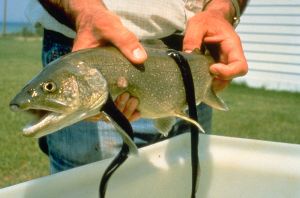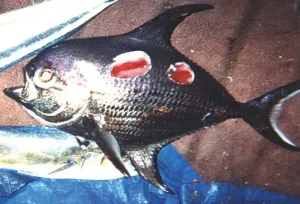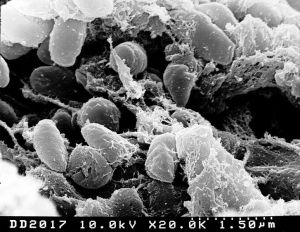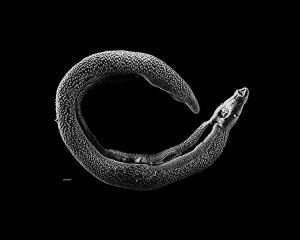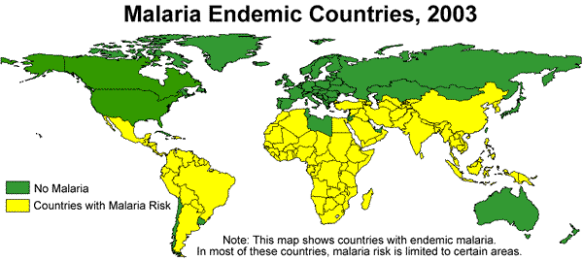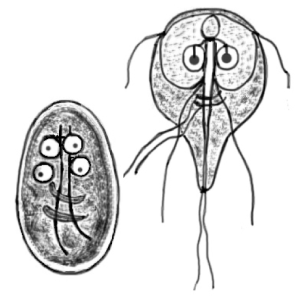My blog has moved! Check out my new home at http://www.weinersmith.com !
One of my many complaints about science reporting…
In my mind, it’s extremely irresponsible when science writers report that a new potential cure for cancer has been found before any serious research has been done. Science reporting would lead you to believe that a new cure is discovered almost daily, when most of these leads are tenuous at best.
Here is a particularly illustrative example. A group of researchers have identified a toxin produced by at least two species of freshwater algae that is responsible for killing over a million dollars worth of fish. Knowing the structure of the toxin may provide scientists with the information that they need to neutralize it. Because fish are important economically and are an important protein source in many parts of the world, this is an important finding in its own right.
But instead of focusing on that or other applications of the discovery, the article focuses on the toxin’s cancer cell killing properties. They exposed cancer cells (presumably in a petri dish?) to the toxin and, low and behold, the cells stopped growing and some of them died. How is this surprising?? They exposed cells to a toxin that they know is capable of killing entire organisms in a matter of hours. You probably could have exposed any type of cell to this toxin and would have seen the same effect.
All the researchers have shown is that the toxin is toxic. It’s safe to assume that the use of this toxin as a treatment for cancer would carry serious side-effects (i.e., in addition to killing cancer cells it would kill any other cell that it encountered as well).
To be fair, the fault doesn’t just lie with the science reporters. Surely the scientists pushed their claims about the toxin’s cancer-fighting abilities in the hope of increasing their project’s attractiveness to funding agencies. It’s a lot more exciting to fund research on a cancer-fighting algal toxin than on a fish-killing algal toxin.
Reporting on the toxin’s ability to inhibit cancer cells should not have occurred until more detailed experiments had been done. Advertising such flimsy leads detracts attention away from methods that are more sound and well-researched while giving the public a false understanding of where we are in the fight against cancer.
Plus, it’s dishonest. This toxin will probably never be an important player in the fight against cancer. Both the researchers and the science reporters are probably pushing the link to draw attention because hell, everyone is excited about finding a cure for cancer.
Anyway, I hope I’m wrong and this toxin is a lot more promising than I think it is. Given the measly 4 sentences the article devoted to actually describing the research on cancer cells, I doubt I am.
On a funnier note, here is one of my favorite SMBC comics, which happens to be about science reporting:
This cracked me up
Before the weekend is over I promise to put up another post on a paper that I’m reading for my preliminary exams. To tide you over until that time, here is a video that absolutely cracked me up:
A system for classifying natural enemies
Step one on the race to my qualifying exams: Know your definitions!
The first paper on my reading list is Trophic strategies, animal diversity and body size by Kevin Lafferty and Armand Kuris from 2002. This paper creates a framework for categorizing “natural enemies” (organisms that obtain their energy by taking it from other organisms). The categories that first come to mind are predators and parasites, but many organisms do not neatly fit into these groupings.
For example, how do you categorize a lamprey? These primitive animals have mouths like suction cups, which contains many sharp teeth. They attach to a fish, bore through its skin, and take a meal of blood and body fluids. They don’t qualify as a typical predator because the taking of this blood meal usually does not kill the fish. They also don’t qualify as a typical parasite because they can attack many fishes throughout their lifetimes, while parasites typically have only one host. So what are they?
Lafferty and Kuris (2002) propose a useful system for categorizing natural enemies based on a set of 4 dichotomous questions. The first question divides natural enemies into the broad categories of predator and parasite while the subsequent questions provide greater resolution.
Here are the dichotomous questions that they posed and the categories that arise as answers:
1) Does the natural enemy attack one or many individuals during its lifetime?
Predators typically attack more than one prey individual over the course of their lives.
Parasites typically attack only one host individual over the course of their lives.
OK, nothing surprising here. Next question.
2) Does attack by this natural enemy eliminate the fitness of the attacked? This question creates categories which will group some of the more ambiguous natural enemies, such as the lamprey mentioned above. It is essentially asking if the natural enemy either kills its host/prey or if eliminates the reproductive potential of the attacked individual. This distinction leaves us with predation, typical parasitism and these two additional categories:
Micropredators: These natural enemies attack many individuals throughout the course of their lifetimes, but do not kill the organisms they attack (i.e., they do not eliminate the fitness of their “prey”). This category includes mosquitos and lampreys.
Facultative micropredators: Some natural enemies will behave as micropredators towards certain prey and as true predators towards others. For example, leeches suck blood (behaving as micropredators) and will also consume entire invertebrates (behaving as predators). Other examples of facultative micropredators listed by Lafferty and Kuris include cookie-cutter sharks, vampire bats, and many herbivores (think of plants as prey).
Parasitoids and parasitic castrators: Parasitoids eliminate their host’s fitness by killing it while parasitic castrators eliminate their host’s fitness by ensuring that they’ll never breed. The next dichotomy will split these two groups, so I’ll discuss them further below.
3) Is it necessary to the natural enemy that the victim die? This is a redundant distinction when thinking about predators, but it is useful for classifying parasites.
Parasitoids: These parasites live in their host for a period of time and kill the host when they are done with it. Parasitoids are typically an insect species that develops inside of another insect host. When the parasitic insect has completed development inside of its host and is ready to be free-living, it bursts out of its host which subsequently kills it. This is an economically important classification of parasites because they are used to biologically control insect pests. For your viewing pleasure, here is a cool video about parasitoids:
Parasitic castrators: These parasites prevent their host from reproducing. For example, barnacles of the genus Sacculina castrate their crab hosts which then care for the parasite’s eggs as if they were their own.
Trophically transmitted parasites (TTP’s): TTP’s have life cycles that include species from multiple trophic levels. The parasite does not directly kill its host, but its host must be consumed by the appropriate predator (and therefore die) in order for the parasite to complete its life cycle. For example, the trematode Euhaplorchis californiensis requires California horn snails, California killifish and predatory birds to complete its life cycle. Thought it does not directly kill California killifish, it requires that the fish be consumed by a predatory bird in order to make it to its definitive host. The parasite is able to manipulate the killifish’s behavior to increase the likelihood that the killifish is consumed by a predatory bird, but it doesn’t kill the killifish directly (here is a previous post on this host/parasite system).
4) Does the intensity of the natural enemies’ attack have an increasing impact on the victim’s fitness? For example, the intensity of an infection by a parasitic castrator does not affect the degree to which the host is castrated. The host is either castrated or not – there aren’t varying degrees of castration. Determining if the natural enemy is intensity independent (like parasitic castrators) or intensity dependent subdivides the following categories:
Pathogens and typical parasites (attack one victim and do not kill or castrate their host)
Pathogen: Their effects are intensity independent. Consider, for example, the virus that causes the flu. It only takes one virus particle to get into your body and multiply to give you the flu. Whether you initially come into contact with 1 particle or 10 particles, the result is the same in that you get the flu either way.
Typical parasite: The effects of typical parasites on their hosts increase as the number of parasites increase. Viruses typically produce offspring that attack the current host, while parasitic worms, for example, often produce offspring that leave their “parents'” host in search of new hosts. This means that an increase in the number of reproducing adults is what leads to increased pathology, making the effects of typical parasites intensity dependent.
Trophically transmitted parasites and pathogens (attack one victim and eventually require the death of their host for transmission to their next host)
Trophically transmitted typical parasite: As described earlier, these parasites infect one host and require their host’s death at the hands of the predator that is the next host in the parasite’s life cycle. Their effects are intensity dependent. For example, the more Euhaplorchis californiensis that infect a California killifish the more successful these parasites are at getting the host to behave conspicuously. Conspicuous behavior attracts the parasite’s definitive host, which is predatory birds (Lafferty and Morris 1996).
Trophically transmitted pathogen: These are pathogens that infect one host and require the host’s death in order to be transmitted to the next trophic level. Their effects are intensity independent for the same reason described for typical pathogens. Trophically transmitted pathogens are less common than trophically transmitted parasites (and quite honestly I can’t come up with an example of one).
Parasitoids and trophically transmitted castrators (attack one victim and either castrate or directly kill their host)
Trophically transmitted parasitic castrators: These parasites castrate their hosts and are intensity-dependent because a more intense infection results in more efficient modification of the host’s behavior in order to increase transmission to the next trophic level (i.e., in order to get the host eaten by a predator that is the parasite’s next host).
Parasitoids: Because the final effect will always be the host’s death, their effect is intensity-independent.
Social and solitary predators (attack more than one individual and kill it)
 Social predators: If more than one predator is required to take down a particular prey item, then social predators are intensity dependent. For example, one lion may not pose a threat to a large elephant, but an entire pride of lions would have a good chance of killing it.
Social predators: If more than one predator is required to take down a particular prey item, then social predators are intensity dependent. For example, one lion may not pose a threat to a large elephant, but an entire pride of lions would have a good chance of killing it.
Facultative social predators: Most social predators are facultative social predators, meaning that they are capable of killing some prey while hunting alone and also of hunting socially to take down larger prey.
Solitary predators: Solitary predators are intensity independent.
Who cares?
OK, now that I’m done with that long list of definitions and classifications, it’s important to step back and ask why this is important. Is this all just an exercise in semantics or are these divisions actually useful in some way?
Ecologists (and scientists in general) spend a lot of time arguing about definitions. The primary reason that we do this is to avoid confusion. These divisions also allow us to make more accurate and useful ecological models. Typical parasites that are transmitted between members of the same species will have very different ecological consequences than trophically transmitted parasites that are transferred up the food chain. Being more specific also allows us to be clear about which groups of organisms are appropriate to apply the results of theoretical models.
Well, that was the first half of that paper. 🙂
The race begins!
The time has come for me to study for the oral portion of my qualifying exams.
In order for a PhD student to advance to candidacy and start her dissertation, she has to pass a written and an oral exam. Different schools and different fields handle the exam differently, but in my program the written part of the exam is taken during the first year, and the oral part is taken at the end of the second or beginning of the third year. I’ve already passed a written exam on ecological principles and must now prepare for the oral portion.
 My oral exam committee is comprised of 5 members who are each responsible for quizzing me on one topic. The topics are estuary ecology, behavioral ecology, mechanisms of behavior (i.e., genetics and endocrinology), quantitative methods (statistics and modeling techniques) and ecological principles. I’ll spend approximately 30 minutes presenting my dissertation topic to them and the next 2.5 hours fielding questions related to the fields mentioned above. It’s on bitches.
My oral exam committee is comprised of 5 members who are each responsible for quizzing me on one topic. The topics are estuary ecology, behavioral ecology, mechanisms of behavior (i.e., genetics and endocrinology), quantitative methods (statistics and modeling techniques) and ecological principles. I’ll spend approximately 30 minutes presenting my dissertation topic to them and the next 2.5 hours fielding questions related to the fields mentioned above. It’s on bitches.
If I pass, I advance to candidacy and begin research (woohoo!). If I fail, I either have to take the exam again, or I have to jump through hurdles of the committee’s choice to prove that I know my stuff. If I fail again, I’m out of the program.
On the plus side, I’m expected to spend the next few months seriously studying the topics that I want to spend the rest of my career working on. How cool is that?!
Some of the questions I’ll study include:
1) What role do parasites play in food webs?
2) What role might parasites have played in the evolution of sex?
3) What is an estuary? What ecosystem services do estuaries provide?
4) What do we know about the role of testosterone in behavior? What about its role in immunity?
5) What do we know about the role of cortisol in behavior? What about its role in immunity?
6) What do we know about how dopamine and serotonin influence behavior?
7) How do parasites influence mate choice?
Your mission, dear reader, is to help whip me into shape! As I study for my oral examination topics I’ll create posts highlighting the cool things I’ve learned. If you have a question related to the topic I’m posting about, please ask. This will help me get a more complete understanding of the topic. If you think I’ve described something in a vague way, call me out. Vague descriptions probably mean I don’t completely understand what I’m talking about.
OK, I’m off to read my first assigned paper!
Divorce in parasites
I’m sorry to break it to you, but all of those beautiful stories about swans and other birds being completely monogamous are rubbish. The more genetic testing we do, the more often we find that species once thought to be monogamous are actually cheating on each other fairly regularly. Behavioral ecologists have also noted that individuals of “monogamous” species will occasionally leave their present mate to go find a new one, a phenomenon we refer to as “divorce”.
That’s right, if you’re sitting in a room of behavioral ecologists you might hear us talking about how often ducks, fish, primates, lizards, rodents, etc get divorced. It’s a strange little world we live in.
Anyway, I found a neat paper today on divorce rates in the more-often-than-not monogamous trematode parasite, Schistoma mansoni. Before I tell you more about the study, here is some background on one of the most important parasites in the world from a human health and socio-economic perspective.
Schistosomes
Schistosomiasis is a disease that effects approximately 200 million people and results in 20 million deaths a year in tropical and neotropical regions. Infection with a schistosome parasite produces a number of unpleasant symptoms, including bloody urine, abdominal swelling, fever, enlargement of the liver, and high blood pressure in the portal vein, pulmonary artery or pulmonary vein. The three main schistosome species responsible for the cases of schistosomiasis in humans are Schistosoma haematobium, S. mansoni, and S. japonicum. I’m going to focus on S. mansoni for the rest of the article.
Schistosome parasites require 2 hosts, one of which is a snail and the other a vertebrate. The parasites asexually reproduce in the snail, creating offspring that mature into free-swimming larvae which leave the snail in search of humans. These larvae recognize human skin secretions (mainly by honing in on the amino acid arginine) and swim in the direction of the secretions until they come into contact with human skin.
Once on the skin, the parasites will look for a good place (like a hair follicle) to enter the human body. In as brief a time as 10-30 seconds, the parasites can go from being visible on the surface of the skin to disappearing into the human body.
In the body S. mansoni uses the circulatory system for public transportation. On the journey, the parasites make a brief pit stop at the lungs and then travel to left side of the heart. The parasites then hang out in the heart, waiting for potential partners to arrive on the scene. When two parasites pair up, they sexually mature and journey together to the mesenteric veins.
Male schistosomes have a large groove in their body into which a female schistosome can slip. When a female makes this groove her home, she begins diverting all of her energy into producing eggs while the male continuously pumps food and sperm her way. Female S. mansoni can produce 300 eggs per day. These eggs are the cause of much of the pain and suffering associated with schistosomiasis.
S. mansoni offspring need to make their way into the intestine so that they can hitch a ride with feces to their way out of the body. If the feces end up in water, then the offspring swim out and search for a snail so that the life cycle can begin again.
Unfortunately for us, a lot of the parasites don’t find their way to the intestine and instead end up lodged in various parts of the human body (these parasites apparently have as good a sense of direction as I do). The immune system finds these trapped parasites and forms a protective shell around it called a granuloma. If enough granulomas form in a small area then blood flow is impaired and a number of unpleasant problems follow.
This parasite has been causing humans problems for thousands of years. Numerous historical texts describing diseases plaguing people at that time are almost certainly describing schistosomiasis. In fact, eggs from S. haematobium have been identified in Egyptian mummies dating back to 1200 BC.
The really sad thing about this parasite is that its transmission could easily be slowed by changes in cultural practices or by enhanced sanitation techniques. Much of the world is either unaware of this, unable to afford to make the changes or are set in their ways and unwilling to change.
Divorce in S. mansoni
S. mansoni are fairly monogamous, but mate switching has been observed from time to time. In numerous species (including humans), sex ratio appears to be an important factor in whether or not couples divorce. This means, for example, that divorce may occur more often in populations where there are a lot more females than males around. The researchers in this study decided to examine how divorce rate changes as the proportion of males to females was varied.
As mentioned earlier, schistosomes reproduce asexually when they are residing in snail hosts. These clones were collected and genetic markers were identified so that the researchers could distinguish between clones. In lay terms, this just means that the researchers found a characteristic in each group of offspring that allowed them to be uniquely identified.
The researchers first infected a mouse with males (let’s call them 1M) and females (call them 1F) of known genotypes and gave them time to pair off. After a sufficient amount of time had passed, the researchers added either more females or more males (2F and 2M, respectively) of a different genotype to see if this had any effect on the “monogamous” pairs that had previously formed. If at the end of the experiment 1F females were only paired with 1M males, then the couples had remained monogamous. If 1F females were found with 2M males or if 1M males were found with 2F Females, then divorce and partner switching had occurred.
After retrieving the couples and identifying the clones in each couple, the researchers discovered that sex ratio was an important factor governing divorce rates in S. mansoni. The more males that were present in the population the more likely it was that couples were divorcing and finding new partners.
The researchers were unable to determine whether the divorces were due to females choosing to leave their male partners (the “female choice hypothesis”) and/or if the strongest schistosome males were capable of prying a female out of another male’s groove (the “forced divorce hypothesis”). Either way, the more males that were present the less stable were the schistosome “marriages”.
I thought this was a really cool use of genetic techniques to figure out what’s going on in a world that can’t be observed directly. It was also neat that they were able to show a factor we know to be important in the mating behaviors of many vertebrates (i.e., sex ratio) is also important in trematode parasites.
—
Reference:
Robert’s and Janovy’s Foundations of Parasitology (8th edition)
Malaria vaccine!
I’m catching up on the science news that I missed in the last few weeks and discovered this article on a research group that has developed a vaccine for malaria.
Over half of the world’s population live where they are at risk of contracting malaria. In areas where malaria is common it is an enormous drain on the economy, imposing massive health care costs and preventing people from going to work. In fact, malaria-ridden regions have a 1.3% lower gross domestic product (GDP) than nearby areas that are not plagued with the disease. Malaria is also deadly. The WHO reports that a child dies every 30 seconds from malaria.
Malaria is caused by protozoan parasites of the genus Plasmodium. Although a handful of Plasmodium species are capable of causing malaria, only one (Plasmodium falciparum) is frequently associated with lethal cases of the disease. The parasite reproduces sexually in Anopheles mosquitoes and lodges itself in the mosquito’s salivary glands after reaching maturity. When the mosquito bites a human, the parasite moves out of the mosquito’s salivary glands and into the human bloodstream.
The most impressive thing about malaria is how it manages to evade the immune system. When a Plasmodium parasite enters the body, its first stop is the liver. Here it invades liver cells and begins multiplying rapidly. The liver cells alert the immune system, but the immune system cannot respond quickly enough. The parasite is too fast. Before the immune system can rally the troops, the parasite makes approximately 40,000 copies of itself, bursts out of the liver cell, and goes in search of its next home: a red blood cell.
Unlike liver cells, red blood cells do not contain genes. Without genes the cells lack the codes and machinery necessary to synthesize proteins which would alert the immune system that it is under attack. This buys the parasite some time, but it still has the spleen to worry about…
Red blood cells (RBCs) are usually very squishy, a necessity when your job requires squeezing through tiny capillaries throughout the body. As RBCs age, they get worn out and lose some of their pliability. When they pass through the spleen, it identifies the aging cells and retires them. The spleen would almost certainly destroy any RBC harboring a Plasmodium because the parasite changes the structure of the cell, making it far more rigid. The parasite needs to make sure that the red blood cell never makes it to the spleen.
To stop the RBC in its tracks, Plasmodium creates hook-like proteins that extend out from the RBC and attach to the blood vessels. While this action saves the parasite from ever encountering the spleen, the proteins alert the immune system to its presence.
Over its evolutionary history, this parasite has managed to exploit the immune system’s need for specificity. The immune system first identifies a foreign body by some telltale protein on a cell’s surface (e.g., the “hook” mentioned earlier). Once this protein has been identified, the immune system builds an army which will focus on attacking only those cells that display the protein they have been built to identify. Should that identifying protein change configuration, then the current army of immune cells will be unable to recognize the intruder. In this case, a new army will need to be readied that is capable of identifying the new protein.
Plasmodium reproduces quickly. It multiplies in one red blood cell and will then burst out in search of new ones. Every few generations, these clever parasites will turn on a different gene that codes for a protein hook with a slightly different configuration. By the time the immune system is capable of recognizing and attacking the parasite, the parasite has switched protein hooks and becomes unrecognizable to the army built to destroy it. In this way, malaria parasites often manage to stay ahead of the human body’s immune response.
There are drugs to prevent malaria and there are drugs to treat malaria, but both are often too expensive for people living in malaria-ridden areas to afford. Additionally, malarial drugs often have nasty side effects. Finding a vaccine would likely save lots of money in the long run and would do much to ease suffering. For many years, vaccine research has proceeded without much luck.
The advent of genetic techniques may now have paved the way for the creation of a vaccine.
The vaccine described in the article mentioned above uses a genetically modified version of the parasite. Scientists identified and knocked out 2 genes that the parasite needs during the stage when it is infecting cells in the liver. This genetic modification means that the parasite can be injected into people without posing any threat. The presence of the parasite gears up the immune system, which creates an army which is ready to attack Plasmodium as soon as it enters the body. This eliminates that lag time that the parasite had been exploiting and gives the immune system the edge that it needs to destroy the parasite before it can cause any real damage.
The vaccine has proved to be 100% effective in animal trials and will hopefully be made available publicly in the near future. If the vaccine is affordable enough to be distributed widely then this should have huge human health and economic impacts. Third world countries that are so often plagued by malaria should save millions in health care costs and should experience increased GDP as a result of the healthier work force. Best of all, millions of lives will be saved in the years after the vaccine becomes available.
If you thought this post was interesting, then I suggest reading Parasite Rex by Carl Zimmer. I got a lot of the information that I presented from this book, and it’s a fun read.
Disease transmission and personality
Thanks Jack and Jonathan for a push to get back in the saddle! Experiments have become manageable again (at least for a short period of time) and Zach and my parents have completed their summer visit. Time for SCIENCE!
 One topic that I find particularly interesting concerns how personality traits influence patterns of disease. For example, people who are frequently stressed out are at a greater risk of becoming obese or acquiring heart disease. We often look at disease transmission at a population or community level, but I think individual level differences in behavior are a crucial and understudied area of research.
One topic that I find particularly interesting concerns how personality traits influence patterns of disease. For example, people who are frequently stressed out are at a greater risk of becoming obese or acquiring heart disease. We often look at disease transmission at a population or community level, but I think individual level differences in behavior are a crucial and understudied area of research.
When diseases are transmitted from one individual to another, then social behaviors are an important factor in transmission dynamics. While it’s often difficult to study this phenomenon in humans, numerous social animals provide ideal study systems.
Natoli et al. 2005 is 0ne of the coolest studies that I’ve read on personality traits and disease. This research group examined 3 colonies of feral domestic cats in Europe and collected data on how male personality traits correlated with FIV (feline immunodeficiency virus) infection. According to the article, FIV infections in feral cats are usually lethal within approximately 5 years, at which point the cat’s immune system is too weak to fend off otherwise nonlethal infections.
FIV transmission occurs when one cat bites another, transmitting the virus from its saliva into the other cat’s bloodstream. Bites usually occur when two males are battling over territory or dominance rank or when a male bites a female during sex.
 In order to get a handle on the “personality” of the feral cats in each colony, the researchers logged hundreds of hours taking notes on the frequency with which each cat engaged in aggressive, submissive, affiliative, territorial, display or mating behaviors. They aggregated all of these measures and came up for a single score for each individual that indicated how “proactive” or “reactive” that individual was. Proactive cats more regularly marked their territory, were the most aggressive (often winning aggressive interactions) and often affiliated with other members of the colony. Reactive individuals rarely displayed aggressive behavior and were frequently submissive towards other members of the colony.
In order to get a handle on the “personality” of the feral cats in each colony, the researchers logged hundreds of hours taking notes on the frequency with which each cat engaged in aggressive, submissive, affiliative, territorial, display or mating behaviors. They aggregated all of these measures and came up for a single score for each individual that indicated how “proactive” or “reactive” that individual was. Proactive cats more regularly marked their territory, were the most aggressive (often winning aggressive interactions) and often affiliated with other members of the colony. Reactive individuals rarely displayed aggressive behavior and were frequently submissive towards other members of the colony.
When the behavioral results were compared with information about which cats were infected with FIV, a clear patterns emerged. The males at the top of the hierarchy (i.e., the most proactive, dominant males) were the most likely to be infected with FIV. Their aggressive demeanor meant that they incurred bites more frequently than more submissive males, increasing the probability that aggressive males contracted the disease.
This finding brings up a logical question. If all of these aggressive cats are contracting terminal diseases, why are aggressive cats still around? Well, the first answer to that question lies in that fact the cats don’t succumb to the illness quickly. The disease has a long asymptomatic period during which the cats continue to strut around as if nothing is wrong.
Importantly, aggressive behavior also maintains access to the ladies. Paternity tests revealed that the proactive cats were fathering a lot more of the kittens than the reactive males. Because aggressive dads produce more offspring than submissive dads, we might not expect aggressive behavior to be diminishing anytime soon.
This was a particularly nice study because it examined multiple populations (lending support to the generality of the results), measured lots of behaviors and included a direct measure of evolutionary fitness. It’s rare to find so comprehensive a study.
When dealing with socially transmitted diseases, personality plays a large role in the number of times an individual may be exposed to an infectious agent. In the study described above, aggressive behavior was the key to transmission. In other systems the important relevant measures may be frequency of sexual behavior, energy put into hygiene, number of individuals with which one associates, etc. Personality plays a large role in determining the diseases to which one is most susceptible.
Smart Mites
Parasitologists commonly observe species in which one sex is more heavily parasitized than the other. For example, territorial male impalas carry a much higher tick load than bachelor or female impalas (paper by Mooring and colleagues found here). Territorial males spend less time grooming to remove ticks and instead spend their time watching for intruding males and wandering females.
Most of the explanations I’ve read for why one sex is more heavily burdened by parasites have focused on how host behavior, physiology and immune status influences their infection status. Few studies have examined if males or females have higher parasite loads because parasites are actively choosing one sex over another.
I was excited yesterday to come across this paper which examined whether or not parasitic mites are capable of preferentially infesting one sex. These researchers had previously observed that female bats from the genus Myotis are often infested with more mites than are males and so they decided to examine whether part of this pattern could be explained by the parasites “preferring” females.
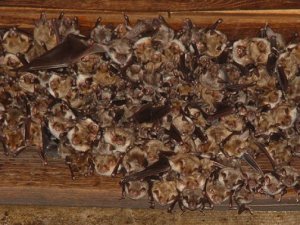 Mites can not survive very long on their own and require a host for food and energy. It’s in the mite’s best interest to try to stay in areas of high bat density. This way they have plenty of other hosts when they reproduce and their offspring need to find a host of their own. It’s also a good idea to have other alternatives nearby in case the bat that the mite is currently living on falls ill and the mite needs to abandon ship.
Mites can not survive very long on their own and require a host for food and energy. It’s in the mite’s best interest to try to stay in areas of high bat density. This way they have plenty of other hosts when they reproduce and their offspring need to find a host of their own. It’s also a good idea to have other alternatives nearby in case the bat that the mite is currently living on falls ill and the mite needs to abandon ship.
If you’re like me, then when you imagine what bats you envision a cave wall with bats crammed in there nose to nose. The bats that roost in these large groups are females with their young. The males on the other hand, are loners. Instead of roosting with the group, they find a place to hunker down on their own. This means that, given a choice, mites should prefer to infest females who will surround themselves with other tasty bats over males encounter other bats far less frequently.
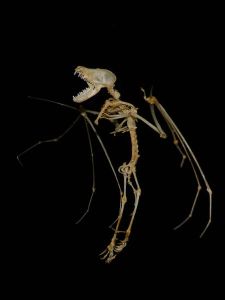 Researchers decided to test whether or not mites were capable of preferentially infecting females given a choice between both sexes. They placed a male and a female bat into an enclosed arena where their movements were limited and released a set number of mites into the enclosure. After keeping track of the mites’ choices, the researchers released the bats into an outdoor arena. Ten days later, the bats were recaptured and mite survival was quantified.
Researchers decided to test whether or not mites were capable of preferentially infecting females given a choice between both sexes. They placed a male and a female bat into an enclosed arena where their movements were limited and released a set number of mites into the enclosure. After keeping track of the mites’ choices, the researchers released the bats into an outdoor arena. Ten days later, the bats were recaptured and mite survival was quantified.
I know lots of people who don’t seem to know what’s good for them, but the mites seem to have it all figured out. The mites choose adult females significantly more often than they choose adult males AND their survival on female bats was much higher than on males.
The exact mechanism by which the mites differentiate between the sexes is unknown, but it’s likely that they’re using hormonal cues.
The more I learn about parasites the more amazed I am at how good they are at keeping themselves alive. This study showed that they’re capable of making good decisions when picking a host and I’ve discussed in a previous post how parasites are able to alter the behavior of hosts that they’ve successfully infected. I wouldn’t be surprised to find that the decisions made by parasites are driving differences in parasite loads between the sexes in lots of other species as well.
My Beef With Bottled Water
Some of the comments on my “Don’t Be a Sucker 101” post accused me of assuming that most people buy bottled water because they wish to avoid the fluoride that is added to tap water. I’m sorry if I was unclear, but I was not making that assumption. I don’t give regular bottled water drinkers THAT much credit.
Here’s the problem.
1) TAP WATER IS FINE IN MOST CASES. Tap water is regularly tested and local municipalties have to abide by super stringent water quality standards. Lots of research has gone into establishing these standards and confirming that the levels of compounds in the water are safe for human consumption.
According to a 4-year National Resource Defense Council report, bottled water companies frequently are not held to the same standards. For example, bottled water companies are not required to test for waterborne parasites like giardia (a parasite that looks like an old man and will give you a nasty case of diarrhea) while local water municipalaties are required to do so.
In fact, the same NRDC report that I mentioned above identified contamination (bacteria, arsenic and synthetic organic chemicals) in nearly 1/3 of the bottled waters that they tested. I tried to read the rebuttal argument to the NRDC report from Bottled Water Web (the “definitive bottled water site”), but only paying members are allowed to view the document.
2) LOTS OF BOTTLED WATER CAME FROM THE TAP TO BEGIN WITH. Between 25-40% of the bottled water found on shelves didn’t come from pristine mountain springs, but from the local water utility near bottled water production plants. On the plus side, this at least means that the water has met FDA standards…
For example, Coca-Cola’s Dasani and Pepsi’s Aquafina come from local water sources and pass the water through a few additional filters before marking it up 10,000% and sticking it on the shelves.
If you’ve examined the research and have decided that you personally believe the levels of certain compounds should be even lower than recommended, then fine. Go find a bottled water company that filters more of this compound out than local municipalities do. I am going to go out on a limb here and say that probably no more than 10% (I think this is a conservative estimate) of bottled water consumers have looked at the research and made an educated decision about buying their water.
3) BOTTLED WATER IS RIDICULOUSLY EXPENSIVE. I’m not convinced that tap water which is already totally safe for human consumption is worth a huge mark-up after being run through a few more filters. During my days in the food service industry (thank god those are over!) I remember selling bottled water to customers for $2.16. I would always offer to give them a glass of tap water, but many preferred the bottled water instead. I found this particularly amusing as we were selling Dasani, which I’ve already noted is simply refiltered tap water anyway. Anyway, if you consider that they could have gotten tap water for free then they’re essentially paying infinitely more for bottled water.
4) PACKAGING AND PROCESSING CAN INTRODUCE CONTAMINANTS. In the past, processing and packaging the tap water introduced bacteria, resulting in water that was less safe to consume than when it first left the faucet (references here and here). The last study that I read on this topic was published in 1998, so I’ll concede that the industry may have cleaned up its act by now. That doesn’t change the fact that the water has encountered a whole lot more surfaces and has had a lot more time to sit and culture bacteria than would water that came directly from the tap.
 5) WASTE. This one is pretty obvious, so I won’t harp on it for long. You can probably imagine how much plastic is wasted in packaging bottled water, but lots of water is wasted as well. For example, producing 1 liter of bottled water requires the usage of 3 liters of water in the production process. Here are some other fun facts.
5) WASTE. This one is pretty obvious, so I won’t harp on it for long. You can probably imagine how much plastic is wasted in packaging bottled water, but lots of water is wasted as well. For example, producing 1 liter of bottled water requires the usage of 3 liters of water in the production process. Here are some other fun facts.
—
To be fair, there are certainly some cases where it may be smart to drink bottled water. For example, if you have a kidney condition and need to avoid fluoride, then researching which bottled water companies remove fluoride and then purchasing water from that company may be a good idea.
If you’re ever in an area where you know the tap water is contaminated or are outside of the US in countries where the tap water isn’t well regulated, then again it might be a good idea to drink bottled water.
To reiterate, if you live in a town in which the EPA’s yearly water quality report has informed you that you have high, unsafe contaminant levels in your drinking water, then I’m NOT talking about you. But you’re in the minority, so I’m talking about nearly everyone else.
There certainly are times when spending a lot of money on bottled water makes sense, but the majority of bottled water sales are purchased outside of these circumstances. Part of the taxes I pay go to ensuring the quality of the tap water I consume. As I live in a city that boasts no water quality problems, I stay away from bottled water as much as possible.


